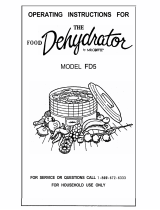Your Automatic Rotating Food Dehydrator provides a fast and economical way to
increase the time that your food will keep. The best way to obtain optimum results is to
experiment and adjust accordingly. There are some guidelines however, that will help
towards obtaining good results.
FOOD SELECTION: Always uses the best quality foods. Fruits and vegetables in peak
season are more nutritious, have better flavor and cost less. Meat, fish and poultry
should always be as lean and fresh as possible.
MEAT AND DAIRY PRODUCTS: The animal fat in meat and dairy products may result in
cracks in your tray. Use the fruit leather sheet with a paper towel underneath when
dehydrating meat to absorb fat and make the cleaning easier.
PRETREATMENT: Pretreated foods often look better and taste better. Check foods for
blemishes and bruises. Foods in bad condition may spoil the whole batch. Remove pits
and peel or core food before dehydrating.
PRETREATMENT OF FRUITS: Fruits with protective wax coating (such as figs, prunes,
peaches, grapes, blueberries, etc.): should be dipped in boiling water which removes wax
and allows moisture to escape easily.Fruits may become dark and colorless after
dehydrating but there are some steps you can take to maintain color in your fruit.
NOTE:
To help maintain color and appearance use either technique:
1. Use vitamin C or citric acid (can be found in most drugstores): Dissolve 2 tbsp of
vitamin C or citric acid in 1 gallon of water. Place fruit into solution for 2 minutes.
Drain well before placing on trays.
2. Use fruit juices such as pineapple juice or lemon juice: Slice fruits directly into juices.
Wait about 2 minutes, then place on tray.
PRETREATMENT OF VEGETABLES: Avery popular way to pretreat vegetables is to
blanch (quickly submerge) them in boiling water or to steam. Blanching does not destroy
helpful enzymes, and it helps keep important nutrients in the vegetables.
PRETREATMENT OF MEATS: Always use lean meat. Remove as much fat as you can
before dehydration.
TIPS
5
5
TIPS
CONSEJOS
Su deshidratador de alimentos giratorio automático le brinda una forma rápida y económica
de aumentar el tiempo en el que sus alimentos se conservarán. La mejor manera de obtener
resultados óptimos es experimentar y ajustar. Sin embargo, hay algunas guías que le
ayudarán a obtener buenos resultados.
SELECCIÓN DE ALIMENTOS: Utilice siempre alimentos de la mejor calidad. Las frutas y los
vegetales de la estación son más nutritivos, tienen un mejor sabor y cuestan menos. La
carne, el pescado y las aves siempre deberán ser tan magros y frescos como sea posible.
CARNE Y PRODUCTOS LÁCTEOS: La grasa animal de la carne y los productos lácteos
podría provocar que se agriete su bandeja. Use la hoja para cuero de fruta con una toalla de
papel debajo cuando deshidrate carne para absorber la grasa y facilitar la limpieza.
TRATAMIENTO PREVIO: Los alimentos con tratamiento previo con frecuencia tienen mejor
apariencia y sabor. Revise que los alimentos no tengan manchas y magulladuras. Los
alimentos en malas condiciones pueden echar a perder todo el lote. Retire las semillas y la
piel o el centro de los alimentos antes de deshidratarlos.
TRATAMIENTO PREVIO DE FRUTAS: Las frutas con una capa de cera protectora (como los
higos, las ciruelas, los duraznos, las uvas, las moras, etc.): se deben sumergir en agua
hirviendo para retirar la cera y permitir que la humedad salga con facilidad, Las frutas se
pueden poner oscuras y sin color después de deshidratarlas, pero hay ciertos pasos que
puede seguir para mantener el color de sus frutas.
NOTA: Para ayudar a mantener el color y la apariencia use una de estas técnicas:
1. Use vitamina C o ácido cítrico (se puede encontrar en la mayoría de las farmacias):
Disuelva 2 cucharaditas de vitamina C o ácido cítrico en 1 galón de agua. Coloque la fruta
en la solución durante 2 minutos. Escurra bien antes de colocarla sobre las bandejas.
2. Use jugos de fruta como el jugo de piña o jugo de limón: Rebane las frutas directamente en
los jugos.Espere alrededor de 2 minutos y después colóquelas sobre la bandeja.
TRATAMIENTO PREVIO DE VEGETALES: Una forma muy popular de darle tratamiento
previo a los vegetales es escaldarlos (sumergir con rapidez) en agua hirviendo o ponerlos al
vapor. Escaldarlos no destruye las enzimas benéficas, pero ayuda a conservar los nutrientes
importantes de los vegetales.
TRATAMIENTO PREVIO DE CARNES: Siempre utilice carne magra. Retire tanta grasa
como pueda antes de la deshidratación.














